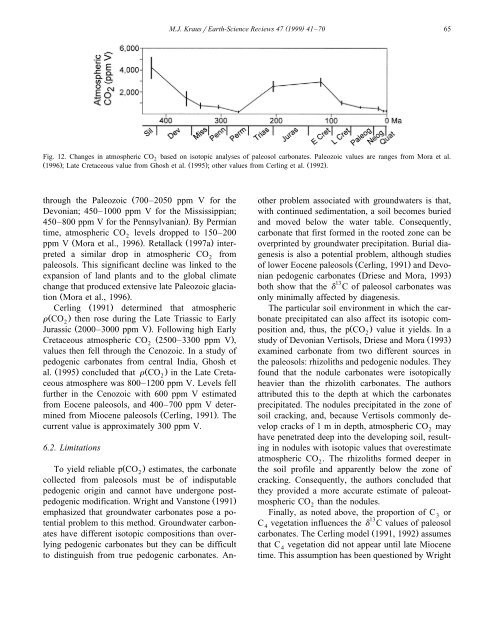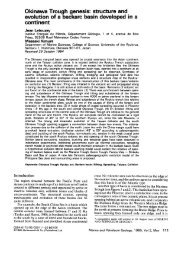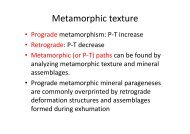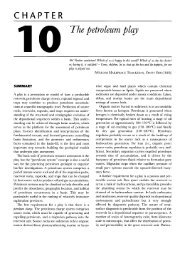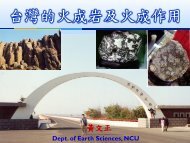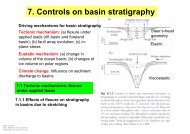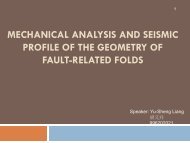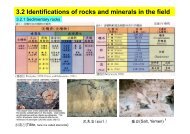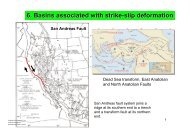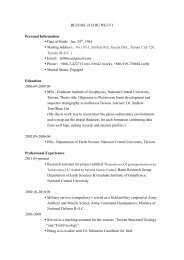64( )M.J. KrausrEarth-Science ReÕiews 47 1999 41–70Although Caudill et al. Ž 1996.concluded thatcalcareous Vertisols might provide an excellent toolfor estimat<strong>in</strong>g ancient MAP, Aslan and Aut<strong>in</strong> Ž 1998.have suggested that caution should be used whenestimat<strong>in</strong>g paleo-precipitation from the depth of calcichorizons, even <strong>in</strong> Vertisols. They observed calciczones Ž Bk and Ck horizons.<strong>in</strong> Mississippi Riverfloodpla<strong>in</strong> soils, many of which are Vertisols. Apply<strong>in</strong>gthe Retallack equation to both natural levee soilsand backswamp soils, they calculated MAP between545 and 908 mm, figures that seriously underestimatethe actual MAP of 1500 mm. Aslan and Aut<strong>in</strong>concluded that the position of the calcite was notcontrolled by the climate. Rather the depth to calcite<strong>in</strong> these soils is controlled by water-table levels andthat calcite precipitates from ascend<strong>in</strong>g, not descend<strong>in</strong>g,groundwaters dur<strong>in</strong>g the wet season. Consequently,they suggested that paleosols that formed <strong>in</strong>aggradational floodpla<strong>in</strong> sett<strong>in</strong>gs are more likely topreserve <strong>in</strong>formation on floodpla<strong>in</strong> sedimentation andpaleohydrology than on paleoclimates.A similar concern about carbonates formed fromascend<strong>in</strong>g vs. descend<strong>in</strong>g waters was sounded bySlate et al. Ž 1996 .. Those authors compared andcontrasted the morphology and isotopic compositionsof carbonates that formed <strong>in</strong> well-dra<strong>in</strong>ed paleosolsand hydromorphic paleosols. They emphasized thatthe Cerl<strong>in</strong>g model should be restricted to soil carbonatethat formed <strong>in</strong> the vadose zone because only hereare all oxidized carbon species <strong>in</strong> isotopic equilibrium.Carbonates from hydromorphic paleosols areunsuitable for isotopic analysis because ascend<strong>in</strong>gground waters probably contam<strong>in</strong>ated <strong>their</strong> isotopiccomposition. This paper is also important because itprovides criteria for dist<strong>in</strong>guish<strong>in</strong>g between soil carbonatesthat formed <strong>in</strong> well-dra<strong>in</strong>ed paleosols fromthose that formed <strong>in</strong> hydromorphic paleosols. Similarly,Pimentel et al. Ž 1996.concluded that carbonates<strong>in</strong> Paleogene alluvial <strong>rocks</strong> were the product ofgroundwater diagenesis, although the carbonates resembledthose result<strong>in</strong>g from pedogenesis. The authorswarned that such carbonates have no particularclimatic <strong>in</strong>terpretation, nor should they be used toestimate sediment accumulation rates on the basis of<strong>their</strong> degree of development.F<strong>in</strong>ally, depend<strong>in</strong>g on the nature of the exposureand amount of data available, it may be difficult todist<strong>in</strong>guish climatic controls from other mechanismsthat can produce vertical changes <strong>in</strong> paleosol properties.The uncerta<strong>in</strong>ty that may exist is demonstratedby a study of Lower Carboniferous paleosols byWright et al. Ž 1991 .. An upward change from calcrete-bear<strong>in</strong>gVertisols to paleosols <strong>in</strong>terpreted asferrolytic Vertisols <strong>in</strong>dicates a change <strong>in</strong> soil moisturefrom better dra<strong>in</strong>ed to more poorly dra<strong>in</strong>edconditions. The ferrolytic paleosols also conta<strong>in</strong> anunusual clay assemblage that was attributed to <strong>in</strong>tenseleach<strong>in</strong>g. The authors suggested that either achange <strong>in</strong> local dra<strong>in</strong>age conditions Žan <strong>in</strong>tr<strong>in</strong>sicmechanism.or a climate change to more prolongedprecipitation could have been responsible. Althoughthey favored the climatic <strong>in</strong>terpretation, they admittedthat this <strong>in</strong>terpretation was tenuous because itwas based on only two paleosol profiles from onlytwo localities.6. Interpret<strong>in</strong>g ancient atmospheres6.1. Isotopic analysisCerl<strong>in</strong>g Ž 1991, 1992.provided a model for estimat<strong>in</strong>gancient atmospheric rŽ CO .2 by show<strong>in</strong>g thatthe isotopic composition of soil carbonate is directlyrelated to soil CO 2, which depends on the concentrationof CO2<strong>in</strong> the atmosphere. As noted above, thecarbon isotopic composition of soil carbonates isalso sensitive to the k<strong>in</strong>d of vegetation ŽC 3 vs. C 4plants .. The model assumes that the pre-Miocenevegetation consisted entirely of C 3 plants, becausevarious isotopic studies ŽCerl<strong>in</strong>g, 1992; Cerl<strong>in</strong>g etal., 1993; Quade et al., 1994, 1995; Latorre et al.,1997.have shown a major change from C 3 to C 4vegetation between 8 and 7 Ma. Also of importancefor paleosols studies is the depth of the pedogeniccarbonate because d 13 CO2values become more negativedownward <strong>in</strong> a soil profile to a depth of ;20cm.Us<strong>in</strong>g paleosol carbonates and the Cerl<strong>in</strong>g model,atmospheric CO2values have been estimated forvarious times <strong>in</strong> the Phanerozoic Ž Fig. 12 .. In a studyof pedogenic carbonates of Late Silurian throughPennsylvanian age, Mora et al. Ž 1996.concluded thatatmospheric CO2levels were high for the Late SilurianŽ 3200–5200 ppm V ., then steadily decl<strong>in</strong>ed
( )M.J. KrausrEarth-Science ReÕiews 47 1999 41–70 65Fig. 12. Changes <strong>in</strong> atmospheric CO2based on isotopic analyses of paleosol carbonates. Paleozoic values are ranges from Mora et al.Ž 1996 .; Late Cretaceous value from Ghosh et al. Ž 1995 .; other values from Cerl<strong>in</strong>g et al. Ž 1992 ..through the Paleozoic Ž700–2050 ppm V for theDevonian; 450–1000 ppm V for the Mississippian;450–800 ppm V for the Pennsylvanian .. By Permiantime, atmospheric CO2levels dropped to 150–200ppm V Ž Mora et al., 1996 .. Retallack Ž 1997a.<strong>in</strong>terpreteda similar drop <strong>in</strong> atmospheric CO2frompaleosols. This significant decl<strong>in</strong>e was l<strong>in</strong>ked to theexpansion of land plants and to the global climatechange that produced extensive late Paleozoic glaciationŽ Mora et al., 1996 ..Cerl<strong>in</strong>g Ž 1991.determ<strong>in</strong>ed that atmosphericrŽ CO .2 then rose dur<strong>in</strong>g the Late Triassic to EarlyJurassic Ž 2000–3000 ppm V .. Follow<strong>in</strong>g high EarlyCretaceous atmospheric CO Ž 2500–3300 ppm V .2,values then fell through the Cenozoic. In a study ofpedogenic carbonates from central India, Ghosh etal. Ž 1995. concluded that rŽ CO .2 <strong>in</strong> the Late Cretaceousatmosphere was 800–1200 ppm V. Levels fellfurther <strong>in</strong> the Cenozoic with 600 ppm V estimatedfrom Eocene paleosols, and 400–700 ppm V determ<strong>in</strong>edfrom Miocene paleosols Ž Cerl<strong>in</strong>g, 1991 .. Thecurrent value is approximately 300 ppm V.6.2. LimitationsTo yield reliable pŽ CO .2 estimates, the carbonatecollected from paleosols must be of <strong>in</strong>disputablepedogenic orig<strong>in</strong> and cannot have undergone postpedogenicmodification. Wright and Vanstone Ž 1991.emphasized that groundwater carbonates pose a potentialproblem to this method. Groundwater carbonateshave different isotopic compositions than overly<strong>in</strong>gpedogenic carbonates but they can be difficultto dist<strong>in</strong>guish from true pedogenic carbonates. Anotherproblem associated with groundwaters is that,with cont<strong>in</strong>ued sedimentation, a soil becomes buriedand moved below the water table. Consequently,carbonate that first formed <strong>in</strong> the rooted zone can beoverpr<strong>in</strong>ted by groundwater precipitation. Burial diagenesisis also a potential problem, although studiesof lower Eocene paleosols Ž Cerl<strong>in</strong>g, 1991.and Devonianpedogenic carbonates Ž Driese and Mora, 1993.both show that the d 13 C of paleosol carbonates wasonly m<strong>in</strong>imally affected by diagenesis.The particular soil environment <strong>in</strong> which the carbonateprecipitated can also affect its isotopic compositionand, thus, the pŽ CO .2 value it yields. In astudy of Devonian Vertisols, Driese and Mora Ž 1993.exam<strong>in</strong>ed carbonate from two different sources <strong>in</strong>the paleosols: rhizoliths and pedogenic nodules. Theyfound that the nodule carbonates were isotopicallyheavier than the rhizolith carbonates. The authorsattributed this to the depth at which the carbonatesprecipitated. The nodules precipitated <strong>in</strong> the zone ofsoil crack<strong>in</strong>g, and, because Vertisols commonly developcracks of 1 m <strong>in</strong> depth, atmospheric CO2mayhave penetrated deep <strong>in</strong>to the develop<strong>in</strong>g soil, result<strong>in</strong>g<strong>in</strong> nodules with isotopic values that overestimateatmospheric CO 2. The rhizoliths formed deeper <strong>in</strong>the soil profile and apparently below the zone ofcrack<strong>in</strong>g. Consequently, the authors concluded thatthey provided a more accurate estimate of paleoatmosphericCO2than the nodules.F<strong>in</strong>ally, as noted above, the proportion of C 3 orC vegetation <strong>in</strong>fluences the d 13 4C values of paleosolcarbonates. The Cerl<strong>in</strong>g model Ž 1991, 1992.assumesthat C 4 vegetation did not appear until late Miocenetime. This assumption has been questioned by Wright


